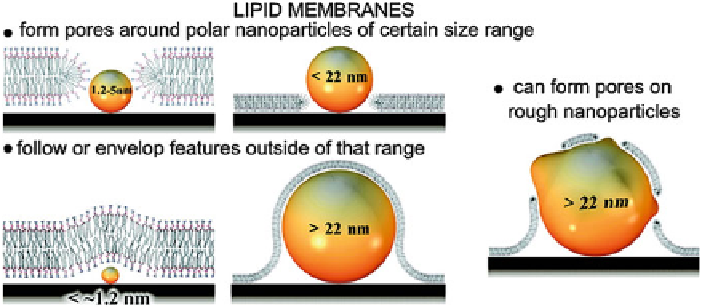Biomedical Engineering Reference
In-Depth Information
Fig. 6.6
An experimentally found nanoscale range of surface feature curvatures where lipid mem-
branes lose integrity and form pores. For direct experimental results see other figures presented
below. The pores were experimentally observed in the l-
α
-dimyristoyl phosphatidylcholine mem-
brane around 1.2-22nm polar nanoparticles deposited on mica surface. Lipid bilayer envelops
or closely follows surface features with the curvatures outside that region. This finding provides
essential information for the understanding of nanoparticle-lipid membrane interactions, cytotoxic-
ity, preparation of bio molecular templates, and supported lipid membranes on rough and patterned
surfaces. This figure with its description has been taken with the publisher's permission from [
22
]
6.4 Novel Nanotechnology: Membrane Transport
of Nanoparticles Through Ion Pores/Channels
Nanoparticles which interact with a lipid membrane as well as forming nanoparticle-
lipid complexes (as explained in an earlier section) may also find themselves to
be trapped right inside the hydrophobic core of the membrane. This trapping of
nanoparticles inside the membrane's hydrophobic core may lead to superior cyto-
toxic effects. We have also learned that larger dimensions in dendrimers and other
polymer nanoparticles may help to induce holes or pores inside membranes. How-
ever, delivery of larger size nanoparticles near the cell environment is challenging,
since the blood vessels which carry nanoparticles can have extremely narrow diam-
eters reaching low nm dimension. This raises the risk of some nanoparticles being
trapped inside the blood vessels even before experiencing release in the vicinity of
the cell. Therefore, off-target cytotoxicity due to nanoparticles becomes inevitable.
Also, the generation of large holes inside a membrane due to the use of sizeable
nanoparticles may permanently destroy the barrier characteristics of membranes.
As a result, cellular processes may suffer non-repairable damage. Consequently, the
freedom of choice in using nanoparticles with various dimensions for drug delivery
is therefore yet to be achieved. With the help of a combination therapy we wish to
propose here a novel application of nanotechnology. This technology will involve the
use of an external agent that modulates specific bilayer properties. Agents that induce
ion-flowing pores inside membranes may appear as useful drug combinations. If a
section of the hydrophobic membrane boundary can be removed for a short period of

Search WWH ::

Custom Search